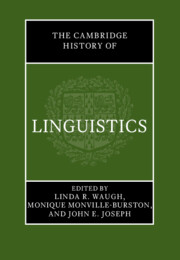Book contents
- The Cambridge History of Linguistics
- The Cambridge History of Linguistics
- Copyright page
- Dedication
- Contents
- Figures
- Tables
- Contributors
- Preface
- Acknowledgments
- Abbreviations, Acronyms, Special Symbols, and Other Conventions
- Introduction
- Part I Ancient, Classical, and Medieval Periods
- Part II Renaissance to Late Nineteenth Century
- Part III Late Nineteenth-through Twentieth-Century Linguistics
- Part IIIA Late Nineteenth Century through the 1950s: Synchrony, Autonomy, and Structuralism
- Part IIIB 1960–2000: Formalism, Cognitivism, Language Use and Function, Interdisciplinarity
- 17 Chomsky and the Turn to Syntax, Including Alternative Approaches to Syntax
- 18 Functionalist Dimensions of Grammatical and Discourse Analysis
- 19 Semantics and Pragmatics
- 20 Language and Philosophy, from Frege to the Present
- 21 Lexicology and Lexicography
- 22 Generative Phonology: its Origins, its Principles, and its Successors
- 23 Phonetics and Experimental Phonology, c. 1950–2000
- 24 Historical and Universal-Typological Linguistics
- 25 Language and Society
- 26 Language and Anthropology
- 27 Language and Psychology, 1950–Present: A Brief Overview
- 28 Semiotics
- 29 Applied Linguistics
- References
- Index
24 - Historical and Universal-Typological Linguistics
from Part IIIB - 1960–2000: Formalism, Cognitivism, Language Use and Function, Interdisciplinarity
Published online by Cambridge University Press: 20 July 2023
- The Cambridge History of Linguistics
- The Cambridge History of Linguistics
- Copyright page
- Dedication
- Contents
- Figures
- Tables
- Contributors
- Preface
- Acknowledgments
- Abbreviations, Acronyms, Special Symbols, and Other Conventions
- Introduction
- Part I Ancient, Classical, and Medieval Periods
- Part II Renaissance to Late Nineteenth Century
- Part III Late Nineteenth-through Twentieth-Century Linguistics
- Part IIIA Late Nineteenth Century through the 1950s: Synchrony, Autonomy, and Structuralism
- Part IIIB 1960–2000: Formalism, Cognitivism, Language Use and Function, Interdisciplinarity
- 17 Chomsky and the Turn to Syntax, Including Alternative Approaches to Syntax
- 18 Functionalist Dimensions of Grammatical and Discourse Analysis
- 19 Semantics and Pragmatics
- 20 Language and Philosophy, from Frege to the Present
- 21 Lexicology and Lexicography
- 22 Generative Phonology: its Origins, its Principles, and its Successors
- 23 Phonetics and Experimental Phonology, c. 1950–2000
- 24 Historical and Universal-Typological Linguistics
- 25 Language and Society
- 26 Language and Anthropology
- 27 Language and Psychology, 1950–Present: A Brief Overview
- 28 Semiotics
- 29 Applied Linguistics
- References
- Index
Summary
This chapter discusses the close interconnection between developments (1960-2000) in historical and universal-typological linguistics, in three general areas:
1. methodology and practice of reconstruction, with debates about comparative reconstruction and typological feasibility; establishment and reconstruction of distant genetic relationships; relation to cross-linguistic variation.
2. expression and interpretation of language universals: implicational universals and typological hierarchies; semantic maps, relating language-specific forms to universal semantic categories; representativeness: sampling methodology, distinction of linguistically motivated vs. accidental distributions; validity (strength) of universals; discussion about whether the only valid universals map function and form, resting on cognitive principles (iconicity, economy); interpretation of synchronic universals as by-products of diachronic principles, or as constraints on possible or (later) probable pathways of diachronic change or reconstruction (e.g., due to instability or low frequency of a given state), or as lying in the mechanisms of language change.
3. grammaticalization: first developments (1970s), intensified interest (1980s) and ‘real boom’ (1990s); phonological, morpho-syntactic, and semantic/pragmatic dimensions; co-evolution of meaning and form (Parallel Paths Hypothesis (PPH)); universal (reduced number of) pathways of diachronic change relating to various aspects of grammar; significant tool in reconstruction; much debate about, e.g., the unidirectionality of change, and the part played by ‘structural reanalysis’.
Keywords
- Type
- Chapter
- Information
- The Cambridge History of Linguistics , pp. 753 - 781Publisher: Cambridge University PressPrint publication year: 2023



